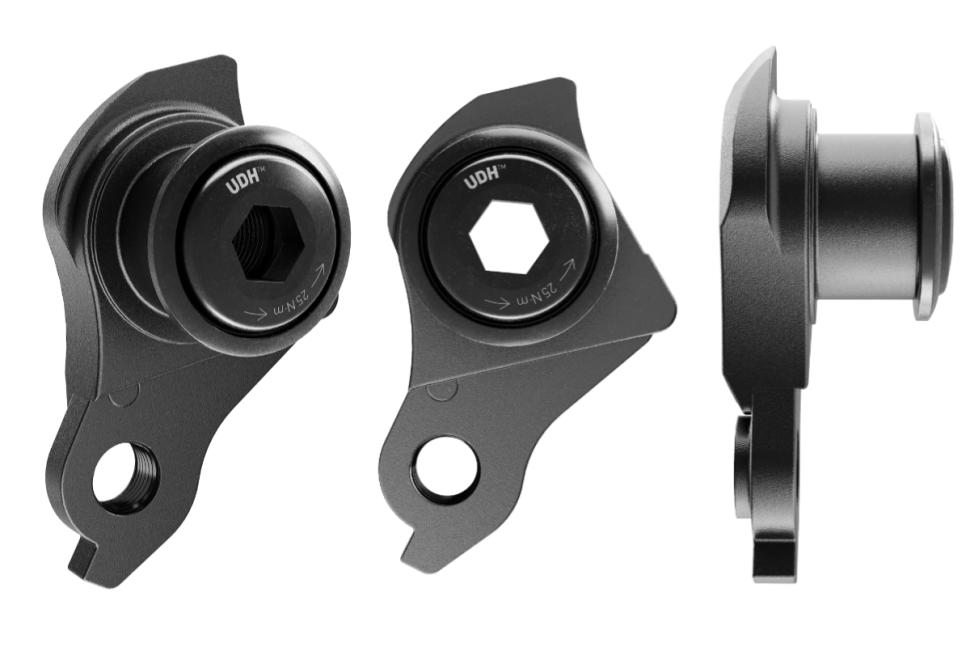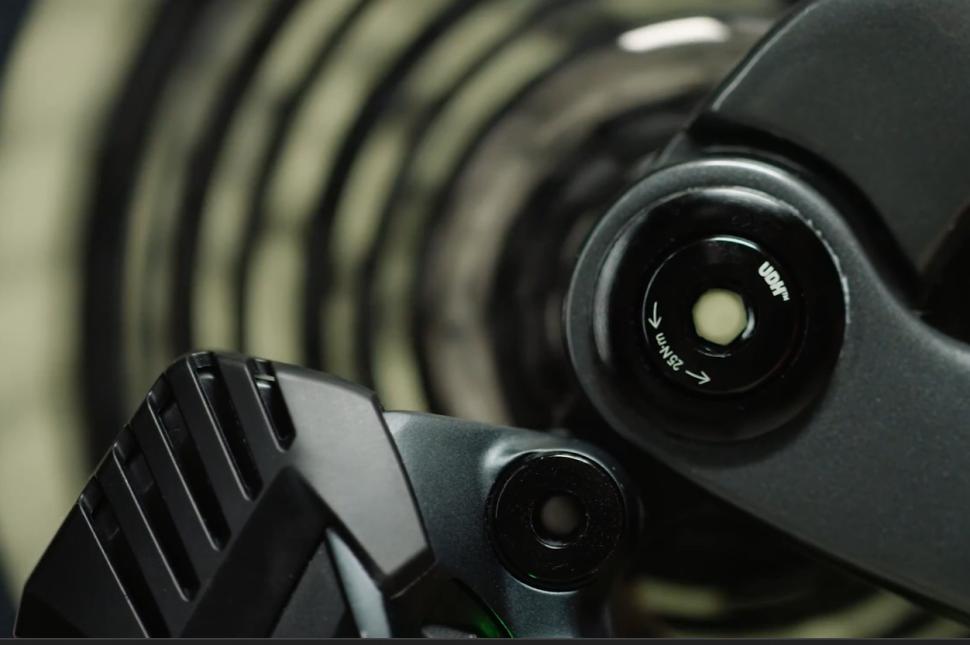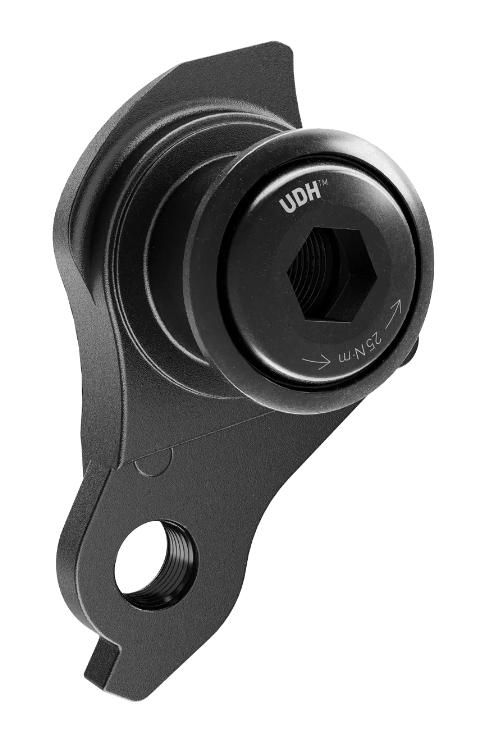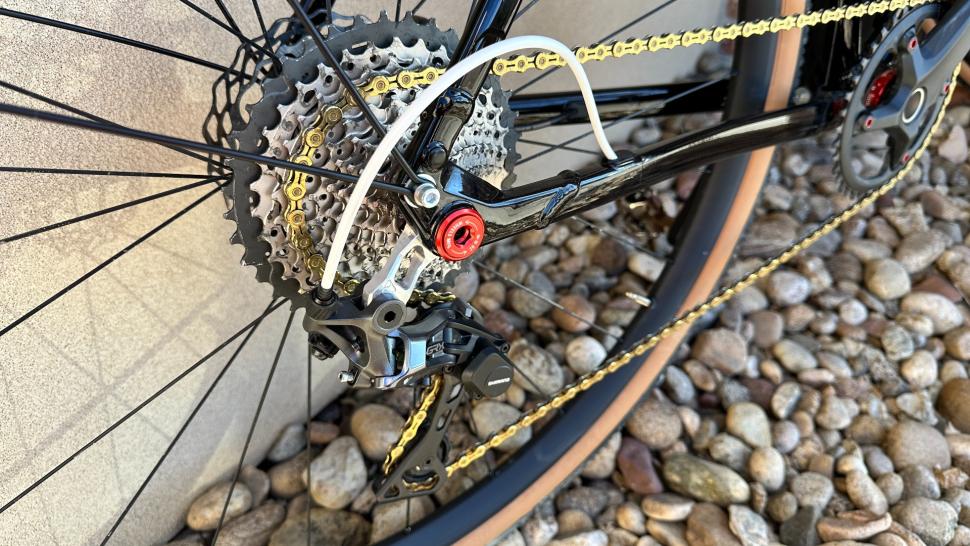- News
- Reviews
- Bikes
- Components
- Bar tape & grips
- Bottom brackets
- Brake & gear cables
- Brake & STI levers
- Brake pads & spares
- Brakes
- Cassettes & freewheels
- Chains
- Chainsets & chainrings
- Derailleurs - front
- Derailleurs - rear
- Forks
- Gear levers & shifters
- Groupsets
- Handlebars & extensions
- Headsets
- Hubs
- Inner tubes
- Pedals
- Quick releases & skewers
- Saddles
- Seatposts
- Stems
- Wheels
- Tyres
- Tubeless valves
- Accessories
- Accessories - misc
- Computer mounts
- Bags
- Bar ends
- Bike bags & cases
- Bottle cages
- Bottles
- Cameras
- Car racks
- Child seats
- Computers
- Glasses
- GPS units
- Helmets
- Lights - front
- Lights - rear
- Lights - sets
- Locks
- Mirrors
- Mudguards
- Racks
- Pumps & CO2 inflators
- Puncture kits
- Reflectives
- Smart watches
- Stands and racks
- Trailers
- Clothing
- Health, fitness and nutrition
- Tools and workshop
- Miscellaneous
- Buyers Guides
- Features
- Forum
- Recommends
- Podcast
feature
 UDH (SRAM)
UDH (SRAM)What is UDH and is it the future of all bikes? SRAM's Universal Derailleur Hanger explained
If we were gambling types, we'd predict that UDH is an acronym cyclists will likely be hearing plenty more about in the next few years. It stands for Universal Derailleur Hanger, and promises a chance to "make shifting simple" with one rear mech hanger design that'll apparently make maintenance and shopping for replacements a breeze. Here's what we know so far...
Invented by SRAM, the UDH is an admirable attempt to declutter the derailleur hanger market, an effort to standardise one single derailleur hanger design and thus eliminate the need for the hundreds of existing standards.
If you're not familiar with what your mech hanger does, it's a rather crucial piece of metal that attaches your rear derailleur to your bike frame's dropout, rather than the derailleur mounting directly to the frame like in days gone by. This means that if your derailleur does break off in a crash, you will most likely just write off the hanger rather than your entire frame.
So financially, the pre-UDH mech hanger is an obvious winner... but if you've ever snapped or bent yours — only to begin the often frustrating and time-consuming mission of trying to work out exactly what replacement you'll need amid a sea of marginally different designs — you'll probably be quite relieved to hear all this about a universal solution.
> Is SRAM looking to kill the mech hanger?
The benefits are fairly obvious for us, the consumer. Mech hangers are very vulnerable to damage, it's a simple fact of crashes, spills and dropped bikes that a small replaceable hanger often won't survive bending or drive-side impacts.
That itself doesn't have to be a problem. We'd rather that than our frames taking more costly damage, but given the ease and frequency of such hanger-snapping mishaps, it makes sense to make the replacement process as easy, simple and cheap as possible, something that shopping a market filled with hundreds of existing standards can at times test the most patient pedaller.
As the UDH product page states: "Today each bike brand designs their own hangers, and may have multiple incompatible hangers across their own models. Multiply this by hundreds of bike brands and you have a very big problem when a rider breaks their hanger and has to find a replacement. The UDH is meant to simplify this."
In theory, if all bike manufacturers ultimately moved to using UDH rather than their own designs, shopping for a replacement mech hanger would become a one-stop retail experience. Pay SRAM's recommended retail price of €18 (£15), or have a shop around to see if there are any cheaper, and fit your part.
Designed for use with thru-axles featuring a diameter of 12mm, it looks similar to other hangers, featuring the body of the hanger and a bolt that keeps it all tight in the dropout, a washer provided for use on some frames. The brand says it is designed to rotate rearwards in the event of impact, theoretically reducing the chances of bending or snapping.
SRAM also says its design means it has the ability to re-rail the chain back onto the small cog and prevents the chain coming off the cassette at the bottom end.
"It offers unparalleled derailleur protection. And perfect alignment. Guaranteed," SRAM claims.
However, the industry remains a decent way from the UDH utopia SRAM dreams of, and predictably there are still compatibility conundrums in the meantime, the hanger compatible with all Shimano's mountain bike groupsets, but being slightly more complicated when it comes to the components giant's road groupsets and those produced by Campagnolo.
Meeting the UDH with the 'Direct Mount' standard used by Shimano and Campagnolo requires use of a B-link, unless you want to purchase a UDH Direct Mount hanger, such as those from US-based Wheels Manufacturing, who have five more expensive hangers for offering "direct mount compatibility with Shimano rear derailleurs to any SRAM Universal Derailleur UDH compatible bike frame". Not exactly the universal single part to make derailleur hanger shopping child's play.
With all that said, the list of bikes using the UDH is ever-growing, SRAM's bike finder compatibility page currently suggesting that 65 models, including 17 road bikes now have it. Trek's latest editions of the Madone, as well as selected bikes from Cervélo, Ridley, Cipollini, Lauf and 3T.
On the gravel side of things, there are even more, with big-name brands such as Specialized, Canyon and BMC all using the tech. Earlier in the summer, we reported that Specialized's new S-Works Crux gravel bike had been updated with UDH compatibility.
Increased standardisation across bikes and brands has been wanted by many for a long time now, the wide range of types, sizes, standards, widths etc. across some parts seen as frustrating and puzzling, even for seasoned home mechanics, and outright baffling for newer riders.
One such standardisation example is Shimano's move towards Cues, offering riders new cross-compatible groupsets for city, touring and mountain bikes, the aim to eventually consolidate its lower-end Claris, Sora and Tiagra groupsets under one roof
Last year we saw a new 9,10 and 11-speed, disc-brake-only drivetrain ecosystem announced, meaning everything below mechanical 105 will be slowly phased out on flat bar bikes, with the likelihood that these changes would be coming to drop bar bikes too in the not too distant future.
> Chapeau, Shimano: CUES looks like a genuine game changer for bike shops, brands and consumers
More recently a new drop-bar groupset was seen on the Cube Nuroad Pro gravel bike, likely slotting in between the more premium GRX offering and budget road bike groupsets, Shimano telling us "more information will be shared in early 2025".
Dan is the road.cc news editor and joined in 2020 having previously written about nearly every other sport under the sun for the Express, and the weird and wonderful world of non-league football for The Non-League Paper. Dan has been at road.cc for four years and mainly writes news and tech articles as well as the occasional feature. He has hopefully kept you entertained on the live blog too.
Never fast enough to take things on the bike too seriously, when he's not working you'll find him exploring the south of England by two wheels at a leisurely weekend pace, or enjoying his favourite Scottish roads when visiting family. Sometimes he'll even load up the bags and ride up the whole way, he's a bit strange like that.
Latest Comments
- Rendel Harris 2 sec ago
To rhyme with design. I wondered this myself so looked it up a while ago, according to the founder Micki Kozuschek he and his team had a few...
- Rendel Harris 53 min 14 sec ago
It's not being pedantic at all, careless driving is successfully prosecuted (and I have been in court more than once when a driver has been...
- HLaB 1 hour 16 min ago
It's hopefully an urban myth but I heard it was designed that way on purpose, so the cyclepath captured any flooding and the busway would remain clear
- mdavidford 1 hour 19 min ago
I should imagine eating chopsticks anywhere could be potentially rather perilous.
- Rendel Harris 1 hour 37 min ago
When The Badger stopped for protesters (albeit dockworkers rather than farmers) it was their stress gauges rather than his that would have been...
- mdavidford 1 hour 38 min ago
Never mind that. More importantly, since when does a bike lock qualify as a 'tool'?
- Eurodolphin 2 hours 23 min ago
Having experienced a brain injury (while my helmet only suffered a little crack) I welcome all this excellent research which looks for ways to...
- mattw 2 hours 25 min ago
Nope. Has anyone ever bought a wheel trim studded with diamonds for their car? Thought not.
- David9694 2 hours 49 min ago
Dad of William Brown Jr battles Folkestone Town Council over illuminated sign featuring late son’s picture...







Add new comment
27 comments
So riddle me this.... why did Shimano's direct mount never become a standard.... now apply the same to UHD.
Since UHD requires a custom drop out it will never be a standard.
Now if Sram had designed their new UHD mechs to sit far enough outboard that you could fit a UHD on a custom Thru Axel then it would have a chance of truly becoming a standard.
No retro fit - no standard.
I'm not familiar with the Shimano Direct Mount design, however I do believe that the design did have problems. Also there wasn't many other fundamental design changes emerging to suit it at the time.
The UDH is not retrofittable purely because it has been developed in conjunction with new wheel standards - as in 100/142x12mm thru-axle standard which is only available on the current breed of disc brake bikes. Some disc bikes have still been using 135mm QR until fairly recently, and still seen on the cheapest disc bikes. As it is such a small area to work on, the UDH adoption can be quite easily worked in to a new design - existing non-UDH dropouts are not so fundamentally different except being bonded in or machined out of a frame's existing structure.
As for T-Type design, the mech is modular to allow for serviceability and repair.
@Matthew
Thats not correct afaik.
UHD requires a new design of right hand drop out.
So every 142/12mm frame produced in the last 6 odd years is incompatible.
As is so often the case in the bike market they have pursued an ideal technical design for new bikes only. Completely forgetting that upgrading older bikes is a decent sized market.
No, only those that weren't designed with the UDH are incompatible. That's a fair proportion, yes, but not all.
I didn't say that existing thru-axle frames were compatible - just that the axle standard is new and tech surrounding it is still being developed. Existing frame designs - as in the blueprints and CAD models - can easily incorporate the UDH into the design for future production. But as bike design often evolves quickly in the modern aero arms race, a number of innovations that have come and gone have lead to many more difficulties in obtaining spares than the UDH has caused.
The UDH was designed around the existing wheel and axle standard.
Yes, that means that 6 years of bike frames can't have UDH, but also a lot of the older bikes that still exist are rim brake and aren't compatible with most of the current performance groupsets and wheelsets out there.
I have a rim brake bike from 2016 that sourcing a hangar would be extremely difficult, if not impossible - Tifosi frames are badged up open mould Chinese imports for which they don't keep records, and there's no stamp or part number on the damn thing. Semi integrated cable routing (headset external, internal downtube) means that electronic shifting that uses any type of cable, (old Campy EPS, any Shimano DI2, even the semi-wireless sdue to central battery) are not compatible. It's SRAM AXS rim brake (very difficult to obtain) or mechanical drive train only.
I can't exactly swap out many if any parts at all from my 1949 Claud Butler and my 2012 Boardman - 27"x1.1/4" vs 700Cx25mm wheels & tyres, 1x4 vs 2x10 drivetrains, 120mm 3/4/5 speed screw on hub vs 130mm 11 speed HG freehub, 26.0mm vs 31.7mm seatposts, threaded headset and quill stem vs 1 1/8" Ahead design. Cottered cup & cone crankset & bb vs sealed cartridge square taper.
I'm not all over the detail of this, but has SRAM not succeeded in using UDH as a bit of a trojan horse - got manufacturers to design UDH compatible frames, so that they are suitable for their T type transmission?
Yes, they have been very clever, but the UDH only works and been widely adopted because you can fit pretty much all other mechs to it (there is probably a mech out there that doesn't fit, but I can't think of any from last 25+ years).
It is and it isn't. Yes, it has led to a UDH specific drivetrain design, however the UDH is compatible with others, leaving customers free to choose. You can still mount Shimano, Campagnolo or even a Chinese alternative to a bike frame with the UDH.
It's only if you want the new T-Type drivetrain that you need a UDH equipped bike. It would not have been possible to do this without pushing the UDH design on to the market in the first place.
SRAM have also licenced out the design patent so that other companies can make them. The premise being that any bike shop in the world will have some UDHs in stock and if you are unlucky to break one, you will always be able to get a replacement no matter where you are.
I do not see your logic there. The ability to retrofit does not dictate whether something is/becomes a standard.
Something becoming a standard is dictated by how widely it's adopted into new products.
That said, using your own logic, the UDH is being widely adopted in part because it allows retrofitting. Not retrofitting of the UDH to old frames, but retrofitting old mech designs to the UDH.
UDH is being widely adopted in MTB land, and rapidly moving into gravel land. It's a standard because its a approach/design that can be incorperated into most/all new frame designs, and allows the use of both traditional mech fitment and the new direct mount T-type mechs (albiet with the actual UDH removed in the latter case).
It's brilliant. Finally we can do away with the hundreds, maybe thousands of different mech hanger designs.
As for shimano direct mount, it was flawed, in part because you could only fit mechs that were designed for it. Even Shimano has given up - the 12 speed MTB and GRX mechs can not be fitted to frames that have the Shimano direct mount hangers (I know this, because I have a Genesis Tarn frame that I've just ditched for that reason).
UDH is backwards compatible, that's the point of it. SRAM T-Type mechs don't need a hanger, they mount where the UDH would otherwise be, and if you want to mount any other mech you use the UDH instead. It's quite well thought out in that regard.
I don't know if it will make much of a dent in road cycling though, it only addresses 1x drivetrains so there's not much incentive for SRAM to promote it and no one's exactly been crying out for a new hanger system. Without a Transmission style groupset there's no need for SRAM to convince frame makers to use this, and without a similar univeral front mech standard there probably won't be a 2x T-Type road groupset
If SRAM really want this to be truly universal, after making a little bit of cash to make back some development costs, then they should offer cheap licences for others to produce or just let anyone make them.
As far as I know, that's alredy the case.
Several brands sell their own UDH hangers, including for eaxample Silca.
https://silca.cc/en-eu/products/udh-derailleur-hanger
£125 (one hundred and twenty-five pounds!) for a derailleur hanger argues that either SRAM are not offering the cheap licences suggested by ktache or that Silica are ripoff merchants (other outlets are offering SRAM UDH for £12.99, albeit aluminium rather than titanium, so my money's on the latter).
Also, minor point I know but it's as annoying as ATM machine or PIN number, "UDH derailleur hanger"? Universal derailleur hanger derailleur hanger...
Silca components are expensive, as any fule kno. Their UDH hanger is made of 3D printed titanium so it's never going to be cheap. Other brands are available.
Slightly peculiar attitude, everyone knows that company's products are expensive so they are not a rip-off? Absolute Black want £800 for a derailleur, well it's not a rip-off because their products are expensive? At a rough estimate the unit cost of a part that size 3D Ti printed would be about £20, no R&D cost obviously as it's an exact copy of SRAM's original, so I think most fule kno that £125 is a bit of a rip-off.
Gotta be honest here, it is YOUR attitude that comes across… slightly peculiar.
What Miller pointed out is that yes, the Silca UDH is expensive, but there are other brands available (as you yourself already stated in a previous comment).
Silca wasn't the best example for me to bring up when it comes to showing that UDHs can be made by anyone.
Whether or not their's is a ripoff (I think their products are stupidly expensive, btw) is not relevant to the discussion we were having.
Add PAT test to that too.....also £125 for a part that's designed to be the weak link is a rip off.
The Silca product is like the CeramicSpeed OSPW - people will pay for the bling despite performance improvements being marginal. It's not aimed at the mass market, there are cheaper options that are easily available. - and there are a number of licences out there which are being utilised at all price points. It means that no matter where in the world, an emergency hangar replacement is easy to obtain should one be needed.
The Silca 3D printed UDH is a touch lighter, but also stiffer when applying shifting load. 13 speed Campagnolo Ekar has been criticised for being fiddly to get indexed correctly, as the margin for error on the cable tension is so small, making shifting less precise and swift that Campagnolo mechanical groups are normally renowned for. The Silca UDH has been touted to mitigate this issue, although UDH is still a relatively new concept to the drop bar world and many bikes equipped are electronic shifting only.
It makes for minimal difference but for someone building an ultralight bike looking to shave as many grams as possible whilst maintaining or improving performance, it may be a go-to item for that niche.
As far as I know, anyone can design UDH into a frame and/or produce aftermarket versions for free. That is one reason why it is being so widely adopted. The majority of new MTBs now have UDH on the frames, and within a year or two I think most new gravel bike frames will be the same.
Obligatory xkcd reference:
https://xkcd.com/927/
Most dedicated MTB frames are all UDH outside of entry level bikes - some 500 bike frame models have been fitted with UDH since its inception. No other type of derailleur hangar (of which there are hundreds of variations) can come close, including designs that have been around for decades. The UDH has been the rare instance of success where bottom brackets, headsets and seatposts have all failed.
Ordinarily yes, unless the new standard is just so good, it does indeed replace all the others, which looks likely with UDH.
Missed the bit about UHD being designed around SRAM introducing their T-Type hangerless derailers to a market of compatible mtb frames. A more universal hanger would be good but this one isn't without compromise. it becomes part of your axle system so needs to be made of stronger material, increasing the chance of damaging the frame or derailer, and shifting operation becomes a lot more dependent on consistent axle torque.
A hangar's failure point is normally between the axle mount area and the mech thread hole, where the hangar does not have a mated surface with the frame. It would not need any compromise as the axle region is contained within the frame - if that's damaged, so are the frame dropouts.
Also the UDH fits and is secured independently of the wheel axle. Shifting issues from poor installation would be no different to any standard hangar design.
Yes, the UDH was a sneaky gateway for it's T-type derailleur system, but the success of the UDH in MTB has solved an age old problem for new bikes.
This has already proven to be rubbish. UDH has now been around for a few years and there have been no reports of shifting performance being affected by thru axle torque, or any widespread reports of frame damage due to the UDH design. Indeed, the general comentary when SRAM launched the t-type mech was that it would result in frame breakages, yet you can literally stand on a SRAM t-type mech without damaging anything.
On a mtb frame. Good luck standing the rear triangle of an 800g road frame
Have you seen how skinny and light weight some cross country frames are? They are on a par with road bikes.
In any case, the point about T-Type is that a significant amount of the forces from mech impacts/bending are passed onto the thru axle and hub, all of which are clamped firmly together with the frame providing a very stiff and strong junction/support.